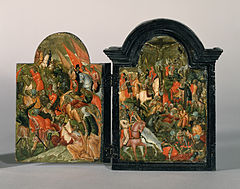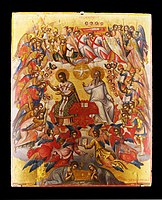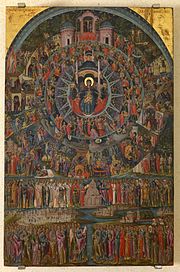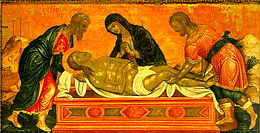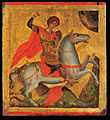
The Heptanese school of painting succeeded the Cretan school as the leading school of Greek post-Byzantine painting after Crete fell to the Ottomans in 1669. Like the Cretan school, it combined Byzantine traditions with an increasing Western European artistic influence and also saw the first significant depiction of secular subjects. The school was based in the Ionian Islands, which were not part of Ottoman Greece, from the middle of the 17th century until the middle of the 19th century. The center of Greek art migrated urgently to the Ionian islands but countless Greek artists were influenced by the school including the ones living throughout the Greek communities in the Ottoman Empire and elsewhere in the world.

Theodore Poulakis was a Greek Renaissance painter and teacher. He is considered the father of the Heptanese School and one of the most prolific painters of Venetian Crete. Poulakis was a member of the Cretan School, his contemporary was Emmanuel Tzanes. Emmanuel Tzanes and Poulakis were active painters of the Cretan School until Candia, went to war with the Ottomans around 1649. Candia finally fell after twenty years of siege in 1669. Poulakis settled on the island of Corfu. Stephanos Tzangarolas was another famous painter in Corfu around the same period. Poulakis's works are likened to Andreas Pavias and Georgios Klontzas. Poulakis works exhibit qualities of the Venetian school. Over 130 of his paintings have survived and can be found all over the world.

Nikolaos Tzafouris, also Niccolo, Niccolò, Niccolö, Zafuri, Zafuris, was a Greek Renaissance painter. He was one of the founders of the Cretan School. He was influenced by Angelos Akotantos. His works influenced Emmanuel Tzanes, Elias Moskos, Georgios Klontzas and Theodoros Poulakis. Tzafouris was one of the most respected artists in Crete. His most notable work is Madre della Consolazione. The painting exhibits a combination of Byzantine and Italian styles. Another notable painter in Crete around the same time was Andreas Pavias. According to the Institute of Neohellenic Research, thirteen paintings are attributed to Tzafouris.

Georgios Klontzas also known as George Klontzas and Zorzi Cloza dito Cristianopullo. He was a scholar, painter, and manuscript illuminator. He is one of the most influential artists of the post-Byzantine period. He defined the Cretan Renaissance. His artistic output included icons, miniatures, triptychs and illuminated manuscripts, commissioned by both Catholic and Orthodox patrons. He is known for occupying his icons with countless figures. The technique is extremely complex and unique to Klontzas. Andreas Pavias attempted this technique in the Crucifixion of Jesus. Klontzas's painting All Creation rejoices in thee is his most popular work. Klontzas influenced Theodore Poulakis he created an extremely similar painting called In Thee Rejoiceth. Klontzas's work is strongly influenced by the Venetian school. His triptychs strongly resemble the works of Gentile da Fabriano, namely the Intercession Altarpiece. Klontzas's Last Judgement resembles Michelangelo's Last Judgement in the Sistine Chapel. There are very close similarities. There is no indication that Klontzas saw the work but it is a possibility. According to the Institute of Neohellenic Research fifty-four items of his art exist today.

Frantzeskos or Franghias Kavertzas was a Greek painter. His painting style resembles the late Cretan School or early Greek Baroque period. His work was influenced by Georgios Klontzas, Michael Damaskinos and Emmanuel Tzanfournaris. He was active in Crete during the early part of the 17th century roughly after the death of Georgios Klontzas. He painted two icons that are very similar to Klontzas's most notable pieces. Theodore Poulakis also painted similar themes. Kavertzas artwork incorporates the Venetian school. His works influenced Leos Moskos. His most notable works are the Last Judgement, In You Rejoiceth.

Ιoannis Apakas, also known as Johann Apakass was a Greek painter and priest. He was active in the latter part of the 16th century to the early 17th century. He was popular artist during his time.

Leo or Leos Moskos was a painter and educator. There were two other painters named Moskos active around the same period, Elias Moskos and Ioannis Moskos, who may have been his relatives. Indeed, Leo is often confused with Elias Moskos. Some of his work was inspired by Georgios Klontzas and Franghias Kavertzas. He traveled all over the Venetian Empire. Records indicate he traveled to Venice, Cephalonia, and Zakynthos His style resembled the Cretan School. He taught famous painter Panagiotis Doxaras. His most popular work is the Last Judgment. His paintings can be found all over the world. Twenty of his paintings have survived.
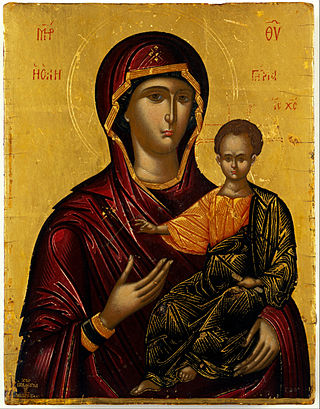
Emmanuel Lampardos, also known as Emmanouil Lampardos and Manolitzis. He was a Cretan Renaissance painter. Emmanuel and his nephew Emmanuel Lampardos have been very difficult to distinguish because they were active painters around the same period. Countless Greek and Italian artists emulated the famous painters. The name Lampardos was very notable in reference to Cretan art. The family was affiliated with famous painters Franghias Kavertzas and Tzortzi Papadopoulo. Lampardos emulated Georgios Klontzas, Michael Damaskinos, Angelos Akotantos, Andreas Pavias, Andreas Ritzos and Nikolaos Tzafouris. His style was the typical maniera greca with a strong Venetian influence. Countless images of the virgin and child have survived. Lampardos influenced Franghias Kavertzas, Emmanuel Tzanes, Philotheos Skoufos Elias Moskos, Leos Moskos, Ioannis Moskos and Emmanuel Tzanfournaris. Over fifty-six icons have been attributed to Lampardos.
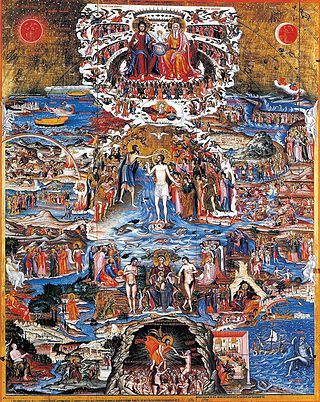
Ioannis Kornaros was a Greek painter. He was one of the few painters from Crete during the 19th century. He does not belong to the Cretan Renaissance but was influenced by the art. He is considered to be one of the foremost icon painters of the Greek Neoclassical era and Modern Greek Enlightenment in art also known as Neo Hellenikos Diafotismos. He implemented a unique style. He was influenced by Michael Damaskinos, Georgios Klontzas, Victor and other Cretan artists. He influenced Modern Greek art. He is one few Greek painters affiliated with Cyprus. Others included Ioannis Kyprios and Theodore Apsevdis. His teacher was Georgios Kastrofylakas. His most famous painting Great Art Thou resembles Georgios Klontzas's In Thee Rejoiceth.

Emmanuel Skordilis, also known as Emmanouil Skordilis. He was a Greek Renaissance painter. He was active in Crete around the time Emmanuel Tzanes, Elias Moskos, and Philotheos Skoufos were painting in Crete. He belongs to the elite group of Greek painters that followed the Venetian influenced maniera greca in Crete. Sixty eight of his works survived. He is one of few artists to not travel to the Ionian Islands and participate in the Heptanese School. He eventually settled in the Cyclades on the inland of Milos. Christodoulos Kalergis is another prominent Greek artist associated with the Cyclades, he was from Mykonos. Skordilis was influenced by Georgios Klontzas, Michael Damaskinos and Angelos. Skordilis brought the artistic style of Crete to the Cyclades and influenced countless artists in that region.

Euphrosynos was a Greek Renaissance painter. He was a priest and influenced by Byzantine art and the early Cretan School. Five of his works have survived, all of them are in Greece. His technique resembled the works of Andreas Pavias, Angelos Akotantos, and Andreas Ritzos. Euphrosynos may have been a member of the prominent Klontzas family. His paintings of the Virgin Mary and Jesus are typical Cretan School paintings. His Jesus painting resembles Pavias's painting Christ Pantocrator. All of his works are at Mount Athos in the Dionysiou Monastery. They decorate the iconostasis. Fragkos Katelanos and Theophanes the Cretan were also working at Mount Athos around the same period.
Manolis Chatzidakis was a Greek Byzantinist. He significantly contributed to the history of art of Greece. He specialized in the field of Byzantine and Post-Byzantine painting. He is considered the 20th century Giorgio Vasari and Bernardo de' Dominici. He was an archeologist, art historian, author, lecturer and curator. He also spoke Arabic and contributed to the field of Islamic art. He helped saved countless artifacts.

The Crucifixion is a tempera painting by Konstantinos Paleokapas. Paleokapas was a Greek painter from the island of Crete. He was active during the early part of the 1600s. Six of his works survived, four are signed. The Crucifixion is one of the most popular events in human history. The scene has been duplicated countless times. Many crucifixion paintings were created by painters from the island of Crete. Some painters included El Greco, Andreas Pavias, Georgios Markazinis and Ioannis Moskos. Paleokapas created his own version of the popular subject. His crucifixion painting followed the prototype of many other paintings thematically. He added both the dice players and the resurrection of the dead. Andreas Pavias’s The Crucifixion (Pavias) and Margkazinis’s The Crucifixion (Margkazinis) both feature the popular pictorial representation of Mathews gospel. Paleokapas’s Crucifixion is located at the Gonia Monastery in Crete.

Lady the Lambovitissa is a tempera painting by Emmanuel Tzanes. Tzanes was a Greek painter active from 1625 to 1690. His artistic periods can be broken into three parts. The Cretan Period (1625-1647), The Corfu Period (1647-1655), and the Venetian Period (1655-1690). He was a prominent member of the Late Cretan School. His art was heavily influenced by Greek painter Michael Damaskinos. His brothers Marinos Tzanes and Konstantinos Tzanes were both painters. Tzanes has a massive art collection attributed to him nearing over one hundred thirty works. During the Corfu Period (1647-1655), Konstantinos Tzanes and Emmanuel were heavily active. They painted many works on the island.
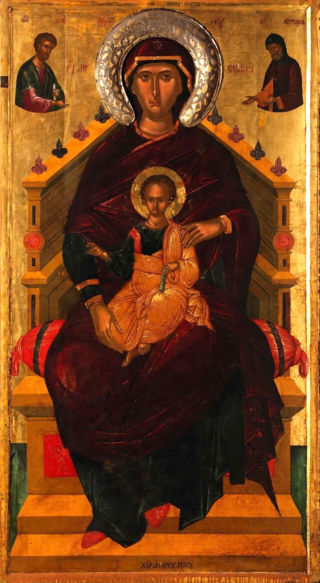
The Virgin Pantanassa is a tempera painting by Andreas Ritzos. Ritzos was a Greek painter active on the island of Crete. He flourished from 1435 to 1492. The painter has an existing catalog of over sixty works attributed to him. He signed his works in both Greek and Latin. He is one of the most influential painters of the Cretan Renaissance. He painted in the traditional Greek-Italian Byzantine style. His work was also heavily influenced by Venetian painting. His teacher was Angelos Akotantos. He was also affiliated with Andreas Pavias. His son was famous Greek painter Nikolaos Ritzos. Ritzo's Italian contemporaries were Paolo Uccello and Fra Angelico. They all painted a mixture of the Greek-Italian Byzantine and Italian Renaissance styles. The art of Crete was heavily influenced by the founder of the Venetian school Paolo Veneziano.

The Virgin Glykofilousa with the Akathist Hymn is a tempera painting created by Greek painter Stephano Tzangarola. The work is a symbol of the craftsmanship of the Heptanese School and the evolution of Greek painting from the Byzantine style to the Cretan Renaissance style. Tzangarola was originally from Crete and migrated to Corfu. The Ionian Islands became the artistic center of the Greek world. He was active from 1675 to 1710 during the Greek Baroque period and Rococo. Twenty-two of his works survived. His student was famous Greek painter and Archpriest Andreas Karantinos.

The Holy Towel is a tempera painting completed in 1659 by Emmanuel Tzanes. He was a representative of the Late Cretan School and the Heptanese School. His brothers were the painter and poet Marinos Tzanes and the painter Konstantinos Tzanes. One hundred thirty works of art are attributed to Emmanuel. He is one of the most important Greek painters of the 17th century along with Theodoros Poulakis. He was from Rethymno Crete. He was active from 1625 to 1690. He was the priest of San Giorgio dei Greci in Venice for thirty years.
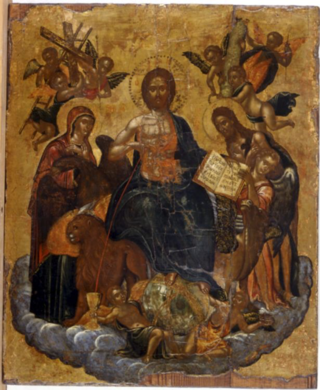
Tribute to the Eucharist was a painting made of egg tempera and gold leaf on a wood panel. The portable icon is attributed to Greek painter Michael Damaskinos. Damaskino's existing catalog features over 100 known works. He was a member of the Cretan school of painting. He was from the island of Crete. His contemporaries were Georgios Klontzas and El Greco. Damaskinos traveled all over Italy for over twenty years. He spent a significant amount of time in Venice. He adopted Italian mannerisms. He applied these new attributes to his paintings. He was friends with sculptor Alessandro Vittoria. He had a collection of drawings obtained from other Italian artists. Namely the Mannerist Parmigianino. He was also exposed to the magnificent works of Italian painter Raphael.

Nikolaos Gripiotis aka Nicolò Gripioti, was a Greek painter and teacher. He was a prominent member of the Cretan School in the early 1500s, working alongside such practitioners as Michael Fokas and Giorgio Miçocostantin. No work survives bearing his signature, but documents from the period record thousands of icons produced by his workshop. Nikolaos's son Ioannis Gripiotis also became a prominent painter. The family was related by marriage to Arsenius Apostolius.

Transfiguration and Monastic Scenes is a multi-themed tempera painting created by Greek painter Georgios Klontzas. Klontzas was a Cretan Renaissance painter. The artist was hired to assess work completed by El Greco. Klontzas was from a wealthy family and owned a successful workshop in the center of Crete. His existing catalog consists of Fifty-four works. He completed incredible triptychs and manuscripts. Klontzas and Micheal Damaskinos are two of the most prominent Greek painters of the 16th century due to the size of their catalogs and the popularity of their works excluding El Greco.






